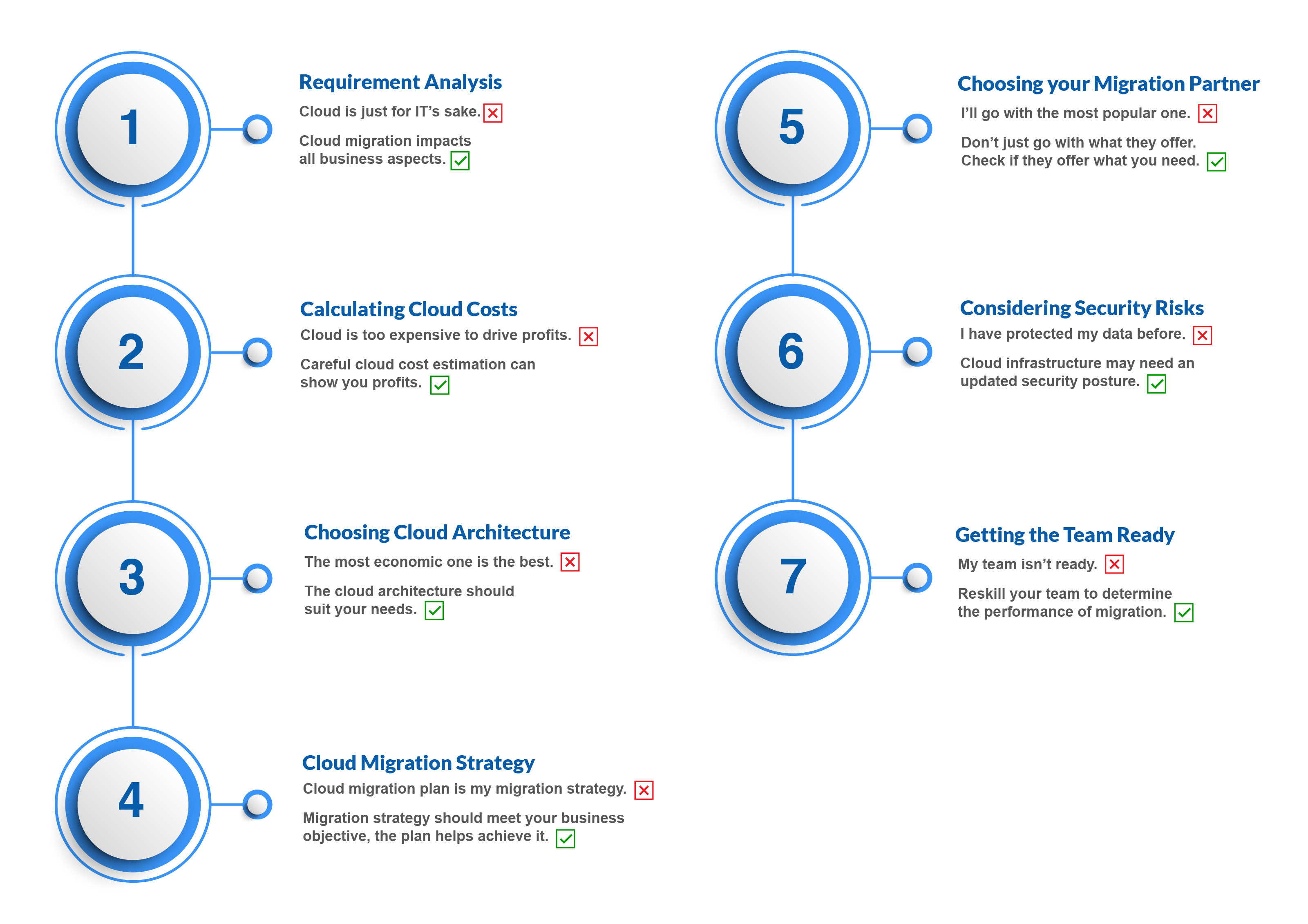This website uses cookies. By continuing to browse the site, you are agreeing to our use of cookies
Prepare for Your Move to the Cloud with a Cloud Migration Checklist – 7 Steps to Follow
Cloud
November 12, 2020
Cloud-based services for IT environment is not a novel concept. However, organizations have seemed to pick up the pace in transforming their on-premises/legacy infrastructure through application migration to the cloud. This paradigm shift has been predominantly triggered as enterprise decision-makers have started to realize the multi-fold growth opportunities that cloud adoption can evidently bring in.
The pandemic has greatly impacted the way businesses think, operate and deliver, and as time progresses, more of them are ready to invest significantly in application cloud migration. As the magnitude of investment widens, it clearly depicts the enormity of returns that organization leaders are expecting. While achieving cost savings and operational efficiency are a few better known benefits of migrating to the cloud, massive improvement in scalability and agility is also aggressively driving organization leaders to move their workloads to the cloud.
An easily agreeable observation is that every business is eager to be an active participant in the cloud gold rush. One of Gartner’s press releases states that several market heavyweights made cloud services a priority investment in 2020 to enable remote working and save costs. The same report puts up a public cloud service revenue forecast that estimates a soar in the cloud services industry – to $306.9 Billion by 2021.
So, we now know that cloud migration is a trending topic of discussion and the race to reach ‘cloud-only’ from ‘cloud-first’ is in full motion, it is imperative for businesses to understand that the migration process may come with its own set of complexities. To encounter those, a Forrester report, emphasizes on the importance of planning, preparing and having a comprehensive cloud migration strategy that will define the outcomes or benefits, if you may, for an organization.
Before you take the giant leap, here is our attempt to help you make the best of the cloud migration process and achieve the lucrative benefits of cloud computing. Here is a cloud migration checklist that should come in handy while undertaking the complex task of migrating your enterprise data and applications.
Cloud Migration Checklist

1. Need Assessment and Analysis
The top spot in your cloud migration checklist should rightly be occupied by estimation of your readiness for the move to cloud and what part of your infrastructure requires to be moved. Simply put, not just the IT framework but the entire business structure has to be considered. The question to be asked here is whether a particular application should be moved to the cloud at all? And if it should, how is it going to affect critical aspects like data security, disaster recovery, accessibility and governance? Considering what apps need to be uninterruptedly accessed on a wider level or if any applications need to be optimized before deploying them on the cloud, may turn out to be resourceful in this scenario. Accurate estimation of the resources to be used for data migration is also vital here, as over or underestimation of capital required may hinder structuring the most appropriate data migration plan. Having said that, as your business objectives keep evolving, you might want to revisit and update your cloud strategy, as well.
2. Considering Cloud Costs
Gartner’s Cloud Strategy Roadmap and Checklist aptly suggests that your decision to go for cloud services should substantially contribute to your CFOs “story to the market”. Identifying cloud costs and keeping a track of the same are crucial to measuring the performance of migration and realizing the much sought after cost-effectiveness through application migration. At times, you may feel the burden of the enormous investment that migration to cloud, all at once, demands. This can, however, be sorted if the migration process is carried out in batches. Spotting the applications that will yield most profitable results when moved to cloud and are comparatively easy to migrate should help you control costs. Some other notable factors that could influence your cloud cost structure are bandwidth and network costs, costs related to reskilling/upskilling the workforce, cost to be incurred while changing license model, if any. Hence, devising a well-calculated cloud costing model can save you the trouble of rushing into an extravagant cloud migration situation.
3. Choosing your Cloud Architecture
As already mentioned, considering your business goals is pivotal for data center migration to cloud. So, while evaluating all the possible options, consider the size of your workforce, the desired scalability of your applications and how security and compliance can get impacted in the process.
Public cloud can be the most suitable choice when you are a mid-sized organization and looking to maximize the scalability of your applications. There could be sets of sensitive and business-critical data that you may want to migrate, to leverage the benefits of cloud computing. Here, the multi-tenant environment of a public cloud won’t be considered suitable. For total control of your infrastructure, you may want to choose a proprietary format of architecture that comes with private cloud. We are talking about a cloud environment that will be dedicated to your enterprise applications. If your requirements comprise a mix of workloads, you can enjoy the best of both worlds with a hybrid cloud environment. So, the security of your sensitive data is retained, and your applications can be scaled up too, when the demand arises. When you do not wish to limit your options to a single vendor, a multi-cloud model is apt. This may prove to be useful when multiple vendors offer differentiated cloud services that appeal to your business objectives.
4. Developing a Cloud Migration Strategy
Now that you have progressed on your move to the cloud, basically, having considered your business, costs and architecture requirements, next on your cloud migration checklist should be to have a strategy in place. One of the major mistakes to be avoided, as pointed out by Gartner, is to confuse cloud strategy with a cloud implementation plan. Your cloud migration strategy can also be defined as an extension of your need analysis, based on which you can prioritize the applications to be migrated, identify the most suitable service provider, decide on the timelines and then chalk out a cloud migration plan with your chosen partner. The strategy talked about here is a projection of your core organizational strategies that will be aligned with a cloud migration strategy to enhance your business benefits.
5. Selecting the Right Solution Enabler:
At most times, enterprises may find it overwhelming to manage migration internally, hence, choosing a suitable service provider can be useful. This would be a collaboration wherein the vendor should ideally be responsible for structuring the entire migration lifecycle – from assessment and planning to actual implementation and support, thereafter. While you skim thorough what each service provider has to offer, your perspective should matter. Factors that should inevitably be considered are compatibility in security and compliance standards, the provider’s pricing details, and the level of availability and support that they provide. Merely zeroing on a partner because of their popularity may not always be fruitful, your enterprise objectives and expectations should be the determinant here.
6. Evaluating Security Risks
You would never want a scenario where your data, sensitive or not, is widely exposed, and hence, addressing data security while migrating to the cloud is nothing less than essential. Negligence in this regard may lead to a range of serious issues – from unwanted availability of your data to cyberthreats and ransomware attacks. While enterprises are mostly aware of the benefits that cloud migration can deliver, it is equally important for them to understand the implications of this shift on their existing infrastructure. Organizations that have a robust security in place can expect smooth sailing here. However, a centralized system that covers security for on-premise workloads may not sufficiently secure cloud-based applications. Revamping the security strategies, based on the preferred service provider’s approach and listed security features is imperative.
Regulatory and compliance requirements should be examined and discussed before initiating the migration process. As your data is transmitted or stored between on-premise or cloud environments, you may want to equip yourself with familiarity of international regulatory restrictions. It will help you understand what and how much data is permissible to be stored, adapt to varied regulatory instructions and maintain compliance.
7. Preparing the Team for the Move
Is the team prepared to use technology that they haven’t before? You certainly would want to ask this question when you have finalized your switch to the cloud. So, how should a team with capabilities to handle applications on cloud, look like? Some of them may be integrally involved in the migration process as well. The focus, here, should be on change management, and the first step should be reviewing your team’s current skill sets and reskilling/upskilling them, however required. Next would be to put together a team of innovators who are adequately trained in the cloud environment and revisit their responsibilities in the organization. As it all starts to flow, naturally, it will be an easy task to segregate the professionals into specialized teams that will enable seamless cloud adoption.
Conclusion:
Although the process of migrating to the cloud can be extensive, complicated and exhausting, adhering to the points mentioned in our cloud migration checklist should bring you closer to the desired results. The primary intent of this checklist is to boost the confidence of enterprises in embracing and adapting cloud migration and gain improved organizational outcomes. Another takeaway could be setting the parameters to measure performance post migration, the performance matrices could be data security, change in response times, agility in disaster recovery, duration of downtime and more. Lastly, as technological advancements are emerging with every passing day, it is only wise to stay updated with the constantly evolving technology in cloud computing and reap its full benefits.
Now that you can depend on this checklist to proceed towards cloud migration, you may want to look at automated, customizable cloud replatforming products specially designed for Java and . Net applications. Hexaware’s AmazeTM for Applications can facilitate seamless replatforming solutions by intelligently identifying the code that is required to be changed. Automation of the migration process can save 50-60% of your manual effort costs, enabling accelerated replatforming in just 4 weeks with improved productivity levels by 25%.
When such a comprehensive, secure and future-proof solution is at your disposal, your application performance is only set to ascend, helping you achieve greater business agility and favorably affecting your ROI.
About the Author

Rituparna Das
Read more
Related Blogs

Understanding Snowflake Cortex for Gen AI Applications with Sensitive Data
- Generative AI
- Cloud
- Data & Analytics

Ready to Pursue Opportunity?
Every outcome starts with a conversation
















